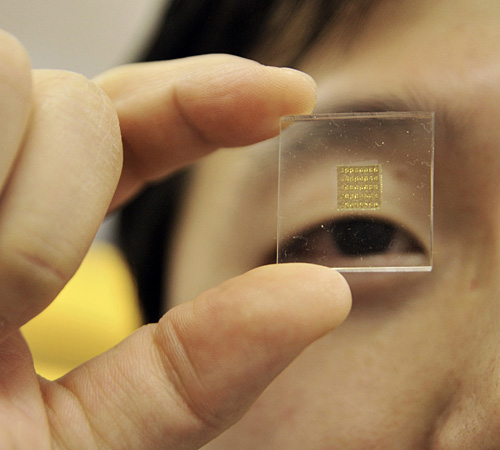UI research makes flexible electronics

Graduate student Dae-Hyeong Kim and John Rogers, professor of material sciences, have developed stretchable, flexible and foldable electronic circuits. Erica Magda
April 4, 2008
Apple may have presented a new laptop thin as air, but with University research, future laptops could be folded up and put in your pocket.
John Rogers, University researcher and professor of materials science, and his research team have developed electronic circuitry that can be stretched, folded or deformed to wrap around objects. The resilient new electronics could be used to make objects such as foldable computer screens, wrist-wearable cell phones or intelligent medical devices.
“The potential of this technology is very high,” said Dae-Hyeong Kim, researcher and graduate student. “There is a huge demand for this type of technology in the military, cell phone and laptop industries.”
Rogers said the research is focused on the application of stretchable circuits and is in collaboration with the University of Pennsylvania Medical School. One of the research projects involves making a biomedical monitoring device that detects and prevents epilepsy. The process requires sensors to be attached to the brain.
A flexible electronic would be able to conform to the sinuous contours of the human brain, Kim said.
Get The Daily Illini in your inbox!
Although the technology is not fully developed, many companies have been advertising future products that will use stretchable electronic technology when it becomes available.
The most mind-stretching – and circuit-stretching – example is the Nokia Morph, a sleek, bendable cell phone so thin it would make a Motorola Razr blush.
According to the Nokia Web site, the cell phone could be folded for easier storage in a pocket or for a more “ergonomic” handset shape. Also, the phone could be unfolded for a larger display.
Rogers said there are two keys to making deformable electronics: making the whole chip extremely thin and pre-treating wrinkles into the chip.
“If you have a sheet of paper and a two-by-four, they are essentially the same material,” Rogers said. “Why the paper is bendable and the two-by-four is not, is because of the paper’s thinness.
“We do the same thing on a microscopic scale.”
In addition, the active parts of the circuit are sandwiched in between two layers of protective polymer, such as rubber or plastic, Kim said.
“(The chip and the protective layers) are very thin, much thinner than a human hair,” Kim said. “They cushion the chip for foldability and twisting.”
The second step to creating a flexible electronic is to pretreat wrinkles into the device for wrinkles to become unfolded when electronic is stretched.
“It’s just like an accordion,” Rogers said.
When an accordion is stretched and compressed, the wrinkles in the accordion allow for the instrument to expand and contract without breaking. The wrinkles in the electronics work on the same scale, he said.
Kim said that when talking about his research, people are often reminded of the movie “Minority Report.”
“The scene where Tom Cruise is moving things around on a computer screen in the air – that is not just an imagination of the future,” Kim said.
“It is happening now.”






